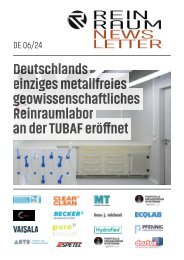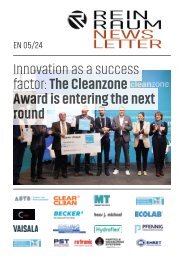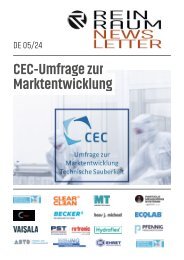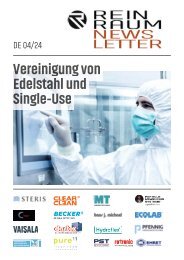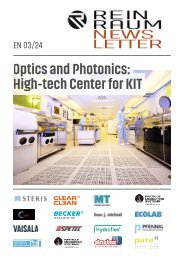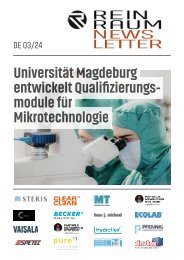Newsletter_07-2024_EN
Create successful ePaper yourself
Turn your PDF publications into a flip-book with our unique Google optimized e-Paper software.
natively a mop with a ready prepared disinfectant solution could<br />
be used).<br />
– Using overlapping mop strokes, wipe down half the floor area,<br />
working methodically around the area starting at furthest reach<br />
point and working towards yourself in a straight line. Replace the<br />
mop wipe if the wipe becomes visibly contaminated or dry.<br />
– NOTE: Particular attention should be paid to corners and edges.<br />
– Leave the disinfectant solution on the surface for the manufacturer’s<br />
recommended contact time to allow the disinfectant to be<br />
effective.<br />
– Remove the mop head and discard to waste.<br />
– Fit a second mop head with ethanol impregnated mop wipe (alternatively<br />
a mop with a ready prepared alcohol solution could be<br />
used).<br />
– After the allotted time, using the fresh mop head wipe down<br />
using overlapping mop strokes to remove any residue, working<br />
methodically around the area starting at furthest reach point and<br />
working towards yourself in a straight line. Replace the mop wipe<br />
if the wipe becomes visibly contaminated or dry.<br />
Use of fumigation<br />
Where disinfection is difficult, is it advisable to use fumigation?<br />
Yes, and this is always advisable following events that can lead to<br />
high rates of contamination, such as maintenance works or a facility<br />
shutdown. Fumigation-based approaches are advantageous for<br />
decontaminating the inside of buildings because they are easily dispersed,<br />
penetrate into difficult to access areas, decontaminate the<br />
interior volume of the space (not only surfaces) and are less labour<br />
intensive than many spray based approaches. Optimal agents are hydrogen<br />
peroxide and chlorine dioxide.<br />
Attention needs to be paid to the concentration and dwell time,<br />
and with controlling temperature and humidity, as well as the mechanism<br />
of dispersing the fumigant. Each of these factors contributes<br />
to the overall efficacy.<br />
“The movement of material or equipment from lower grade or<br />
unclassified area to higher-grade clean areas should be subject to<br />
cleaning and disinfection commensurate with the risk and in line<br />
with the CCS.”<br />
The Contamination Control Strategy refers to risk-commensurate<br />
cleaning and disinfection.<br />
Validation<br />
The validation of detergent and disinfectant products, as well as<br />
the validation of cleaning is a very important step: what are the<br />
mandatory activities?<br />
Validation studies are broken down into three sections: suspension<br />
tests (phase 1 and 2) to evaluate the reduction of a known organism<br />
population inoculated directly into a sample of the liquid disinfectant,<br />
surface tests (phase 2) that assess a disinfectant’s ability to reduce<br />
the number of challenge organisms on an inoculated surface,<br />
and field trials (phase 3) a final assessment of the environmental<br />
monitoring data to validate the approach.<br />
Suspension methods evaluate the reduction= of a known organism<br />
population inoculated directly into a sample of the liquid disinfectant.<br />
Following inoculation and the observation of a predetermined<br />
contact time, samples of the inoculated substance are removed,<br />
neutralized and evaluated for survivors as compared to an untreated<br />
control suspension. Since the simulation of organism films on the<br />
specific environmental surface types are not accounted for in this<br />
method, it is recommended that suspension-based tests be used<br />
only for initial disinfectant screening purposes.<br />
Surface testing involves aliquoting onto a surface coupon a mix<br />
of the challenge organism and, where required, an interfering substance<br />
(such a protein, to simulate dirty conditions). The surface<br />
coupon will be fashioned from a representative surface in the cleanroom<br />
(here several different materials will require testing in order to<br />
show how the disinfectant performs). To this an amount of the test<br />
disinfectant is added. The solutions are left for the required contact<br />
time. Once the contact time has elapsed, the coupon is transferred<br />
to a neutralizer solution. Then, as with the suspension test once sufficient<br />
time has been given for neutralization, microbial survivors are<br />
assessed by plating out or filtering the disinfectant neutralizer solution<br />
using a microbial culture method.<br />
A possible array of surfaces to consider (this will be<br />
facility dependent) are:<br />
– Stainless steel<br />
– Glass<br />
– Aluminum<br />
– Epoxy<br />
– Enamel<br />
– Acrylic<br />
– Mipolam<br />
– Vinyl<br />
– Hardwood<br />
– Plastic<br />
– Plexiglas<br />
– Chromium<br />
Once the testing has been performed, a report should be generated<br />
that must conclude the disinfectant efficacy test outcome in relation<br />
to the acceptance criteria. If a disinfectant passes the test, deeming<br />
it suitable for use, cleanroom procedures must reflect the practices<br />
adopted during the qualification, such as disinfectant concentration,<br />
contact time and method of application to surfaces. The disinfectant’s<br />
final adoption must then be based on a follow-up assessment<br />
or field trial, which includes an evaluation of microbial counts and<br />
species recovered.<br />
Use of sterile concentrates<br />
“Disinfectants and detergents used in grade A and grade B areas<br />
should be sterile prior to use. Disinfectants used in grade C and D<br />
may also be required to be sterile where determined in the CCS.<br />
Where the disinfectants and detergents are diluted / prepared by<br />
the sterile product manufacturer, this should be done in a manner to<br />
prevent contamination and they should be monitored for microbial<br />
contamination. Dilutions should be kept in previously cleaned containers<br />
(and sterilized where applicable) and should only be stored<br />
for the defined period. If the disinfectants and detergents are supplied<br />
“ready-made” then results from certificates of analysis or conformance<br />
can be accepted subject to successful completion of the<br />
appropriate vendor qualification.”<br />
In-house prep: in the latest Annex 1 version there is more focus<br />
on both in-house preparation of detergents and disinfectants and on<br />
the use of WFI water.<br />
What do you think about the use of sterile concentrates<br />
in cleaning and disinfection procedures?<br />
The use of a concentrate that is made up or the use of ready-to-use<br />
solutions, is a choice of each user. Both methods are effective.<br />
www.reinraum.de | www.cleanroom-online.com NEWSLETTER | Edition <strong>EN</strong> <strong>07</strong>-<strong>2024</strong><br />
page 5/28








